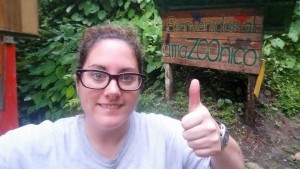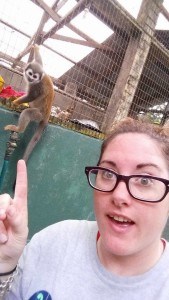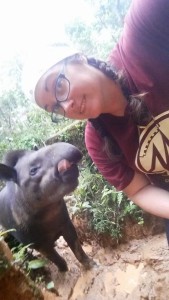Ecuadorian Amazon part 1- Welcome to the Jungle!

Welcome to Amazoonico!
Deadly bugs, hard work, hot sweaty days, incredible animals… I was ready! I briefly visited the Amazon in Peru back in 2007, but it wasn’t an extensive experience. After a 10 hour travel day through washed out roads and a canoe, I arrived at Amazoonico. Amazoonico is an animal rescue center that was founded back in 1993 by a local Kichwa man and a Swiss lady. It is located about an hour and a half east of Tena, on the Rio Arajuno. It is part of a larger project, Selva Viva, which includes 1750 hectares of protected forest, 2 lodges, and a school.
I volunteered at an animal rescue center very similar to Amazoonico in Guatemala, so I knew what the work was going to entail. I didn’t take a lot of photos during my first week, I was simply trying to learn, learn, learn! Shortly after arrival I was put to work since it was afternoon feeding time. I entered the chaos zone known as the bodega. This is where all the food is prepared for the feedings, which happens twice a day.

The craziness in the bodega preparing all the food for the animals meals
Our days start early, at 7am. First things first, food preparation. We organize all the feeding buckets and plates, then start cleaning and chopping away on the various fruits and veggies. There are over 600 animals at the center, so there is a lot of food to prepare! You have to make sure you know what you are putting into each bucket. Some fruits and veggies are toxic and/or deadly to certain animals. For instance tapirs don’t get yuca, and toucans don’t get pineapple. Some animals can eat the peels, some cannot. Some get the seeds and pits of fruits, some do not. Luckily there is a list for each animal hanging on the wall. Better to check and be safe!
After the food is ready, there are 5 feeding tours we split up and do, Mono, Big, Front, Special, and Cuarantina. We have enough volunteers now, 11, that we can usually do two people per feeding tour. This makes things easier, especially in the morning since we have to clean all the cages as well before we feed. The two tours which include the monkey cages require two people at all times. There are systems of ropes used to close and hold the doors shut to lock out the monkeys while another person enters the cage to lock the doors. While there are many sweet animals such as the tapirs, there are also some real ass holey and mean animals, mainly the various species of monkeys.

A squirrel monkey trying to get into the bodega
Speaking of monkeys, there are two species that roam free around the center, the spider monkey and the squirrel monkey. The squirrel monkeys are small and just flat out annoying. They hang on the outside of the bodega and try to sneak in to steal food. Sometimes they successfully enter through an open door… when this happens, “Monkey in the bodega!” is proclaimed, and we all gather up to get the monkey back outside. Oh, and it is their breeding season, so they are even more aggressive. The spider monkeys are quite a bit bigger, and can be aggressive, particularly around food. You have to be very careful, especially in the morning, when carrying your feeding buckets to the enclosures you are feeding, as well as when carrying the compost out. Spider monkeys have attacked volunteers for food. If this happens, just drop the bucket and get out of the way! Another good way to get monkeys out of the way are to spray them with water, they just hate it. This can also just piss them off more, it’s always a crap shoot.
Besides cleaning the enclosures, there are other things to clean. The veterinary area, office area, bar area, our volunteer house, monkey clothes. You learn quickly that Amazon clean is not clean, clean, ha ha ha. You do the best you can with the materials you have, nothing is going to be spotless.
Our volunteer house is comfortable. Most of us have our own rooms. We have 2 common areas with couches and hammocks. We have electricity and cold running water. There is no purified drinking water, so I have just been drinking out of the tap. So far, so good… however I am sure I am filled with parasites from the water and dealing with animal shit all day. I will make sure to get some meds before heading home, just in case.

Crystal and Sareth from Colombia making bolognase for dinner
Breakfast is after from 9-10, and lunch is from 12:30-2. Both of these are eaten up in a kitchen that is next to the office. A local Kichwa lady cooks those meals for us, and two volunteers each night is responsible for cooking dinner for everyone. We typically only get meat a couple days a week for lunch, dinners are vegetarian, and are usually consist of pasta. The animals actually get good fruits and veggies, we hardly ever get fruit! Volunteers have been known to sneak an orito (little banana) from the bodega from time to time.
The center receives many tourists every day, which is good and bad. It’s good since it generates revenue for the center, which in turn buys the animals food. The bad, since we as volunteers are pulled away from working with the animals to give one hour tours of the center. Some volunteers reallty loath the tours, I don’t mind them. I quickly learned the facts and stories of the animals, some of which are heart breaking.
The majority of the animals at the center come from the Ministry of Environment, although the center receives no funding from the government. Illegal trafficking, house pets, and babies whose mothers have been shot are the main reasons the animals end up at the center. The monkeys are the easiest to reintroduce into the wild, while no birds can be released. One third of the animals are dead on arrival or die shortly after coming to the center. One third can be released, and one third will live the rest of their life in an enclosure for various reasons.

Crystal with Navi, a Tapir
My two favorite animals so far are the tapirs (Navi and Carnival), and the aguti named Henry. Both tapirs were basically raised by people, and aren’t bothered by humans. I entered the tapir cage the other day to get some clay to make some enrichments for the birds. Navi came right up to me and started licking my salty sweaty arm! Tapirs are about 500 pounds, and are closely related to rhinos. They haven’t evolved much over the years at all.
I am the oldest volunteer, and the only American. The center has some sort of agreement with the German government, so there are a lot of Germans… half the volunteers, actually. The others are all about 18-21 years old, but for the most part everyone gets along. As with any volunteer situation where you live in a house together, there is a lot of flirting that goes on, especially with all these youngins’.
I have about 4 weeks left, and am looking forward to working more closely with the animals. Enriching the enclosures of the animals is something I would like to focus on. The only thing holding me back is time. If we have a day with a lot of tourists, like we have this first week, we don’t really have any extra time outside the cleaning and feeding tasks. We shall see!










